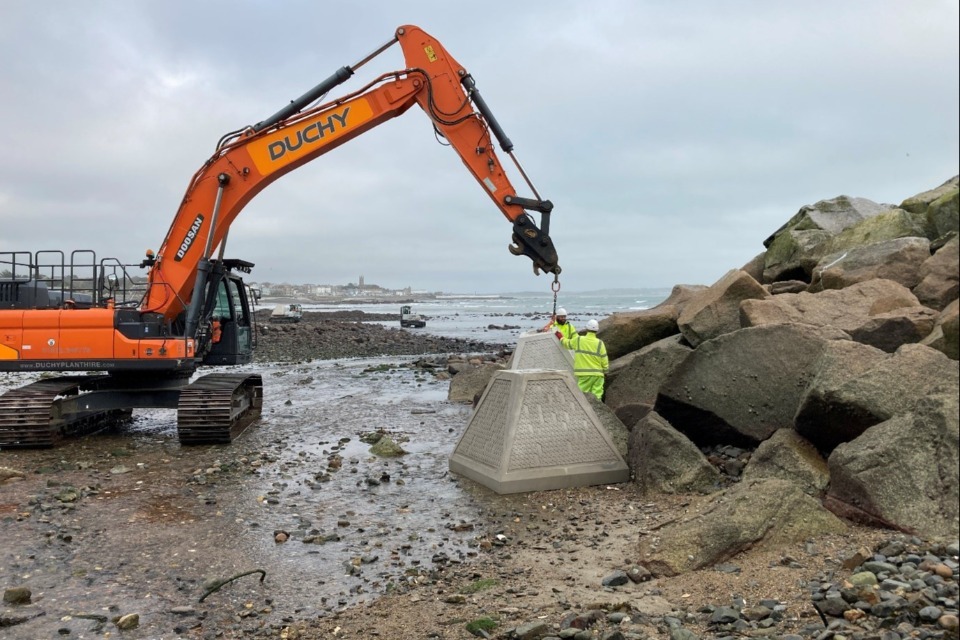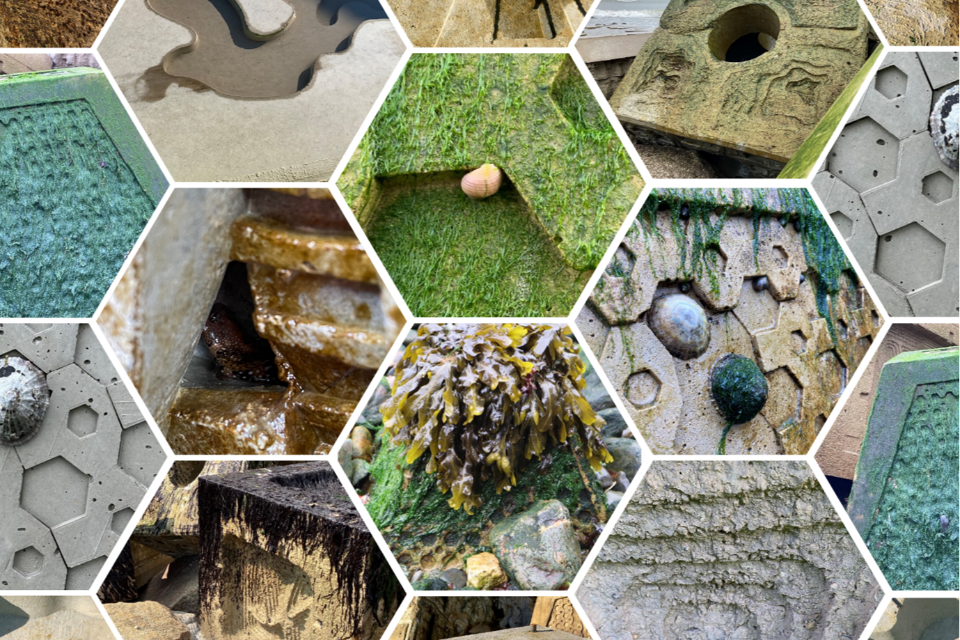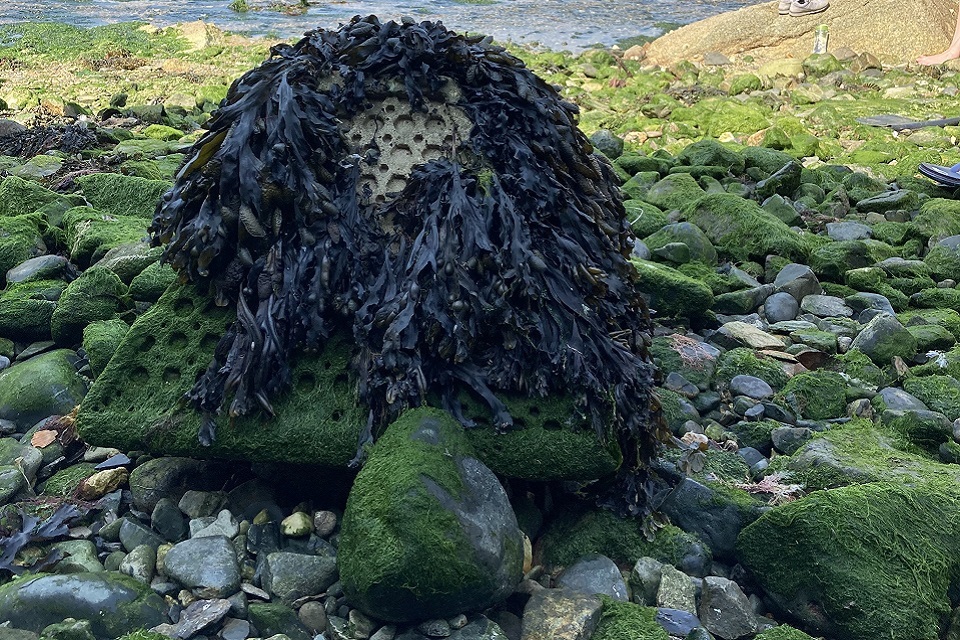Newlyn coastal research and development project
A research and development project investigating the use of eco-blocks as a potential material to be used in future flood and coastal erosion risk management schemes
Documents
Details
Background
The Environment Agency’s national strategy for Flood and Coastal Erosion Risk Management (FCERM) shows we need to move away from the narrow concept of protection. It sets out our vision to move to a wider concept of resilience to flooding and coastal change.
There will always be places around our coast where hard defences are still needed to manage the risks of flooding and erosion. Wherever possible, we want investment in these types of defence to provide additional benefits.
These could include:
- creating new habitat
- providing amenity value
- capturing carbon
One solution is low-carbon concrete armour which is designed to also provide habitat for marine life. We think these ‘eco-blocks’ can be used in the construction of future FCERM schemes. Before we can use them to construct defences such as breakwaters, we need to expose the eco-blocks to high wave energy. This will make sure their features and properties suit the harsh breakwater environments.
Between 2022 and 2023, we worked with Kier and Atkins to install 88 eco-blocks at Newlyn, west Cornwall. This was done around an existing rock armour breakwater.
We are now monitoring:
- the eco-block’s ability to enhance biodiversity and withstand the high-energy environment
- the effect of block size and orientation
We are not aiming to directly reduce flood or coastal erosion risk through this research project.

88 eco-blocks have been installed around the rock armour breakwater
Eco-engineering
We are interested in eco-blocks because they are designed to provide environmental benefits whilst acting as marine and coastal armour.
Compared to more traditional concrete and rock armour they are:
- produced using lower carbon
- specifically designed to promote increased biodiversity
The eco-blocks have been tested to make sure they are safe for use in marine environments. They have similar compressive strength when compared to traditional concrete. Eco-block products have been used and studied in offshore locations.
This project at Newlyn will allow us to investigate their performance in an intertidal location which experiences high wave energy.
Habitat creation
Unlike quarried rock, eco-blocks promote rapid colonisation by marine species.
Their design features:
- an adjusted pH which mimics that of seawater
- rough texturing that helps wildlife attach to surfaces
- nooks and crevices to offer shade and shelter
- pools to retain water when the tide is out
A few weeks after installation we saw a variety of algae and marine fauna colonising the eco-blocks. We think these units will act as ‘seeds’ for greater biodiversity to establish on the granite rock armour of the breakwater.

Habitat features encourage rapid colonisation of the eco-blocks
Low carbon concrete
The pilot is testing eco-blocks made with low carbon concrete mixes. Our suppliers used waste products from industrial processes such as quarrying and steel production. All our suppliers made their eco-blocks in the South West to minimise the transport of carbon. The closest was less than 5 miles from the installation site at Newlyn breakwater.
Funding
The project was mainly funded by EU Interreg’s Sustainable and Resilient Coastal Cities (SARCC) project. Extra funding came from UK government FCERM grant-in-aid.
SARCC partners from the UK, France, Belgium and The Netherlands are investigating nature-based solutions to coastal change. Pilot sites including Newlyn show how we can both benefit the environment and improve the resilience of coastal communities to climate change.
You can find out about other SARCC pilot sites, and watch recorded webinars about nature-based solutions to coastal change.
Monitoring
We carry out ecological surveys every 6 months to help us assess how well marine species are colonising the eco-blocks. We want to find out which of the blocks’ habitat features are most attractive to local wildlife. This will help us get the greatest biodiversity when we use eco-blocks in similar locations.
We regularly inspect Newlyn breakwater to see if any maintenance is needed. These inspections will now include an assessment of the condition of the eco-blocks. We will learn how best to inspect the condition of the eco-blocks without disturbing the wildlife they are designed to benefit.
What we have learnt so far
We placed miniature eco-blocks near the breakwater and monitored them for 2 years before constructing the full-scale pilot. These were successfully colonised by a variety of marine flora and fauna.

A small, trial eco-block, 20 months after being deployed
This trial has helped us to select larger eco-block products from a range of suppliers. We installed a total of 88 blocks, each about 1.3 cubic metres, around all sides of the existing breakwater structure. This means we can compare colonisation of different products exposed to varying amounts of wave energy.
Construction of the full-scale pilot finished in February 2023. We have already seen the eco-blocks being colonised by marine life. For example, algae including purple laver has grown on the surface, and fauna such as snails, limpets and fish are using the habitat features.

Biodiversity is increasing, with algae providing food for other species
Contact details
You can email the Devon, Cornwall and Isles of Scilly enquiries team to find out more about the Newlyn coastal research and development project. You can also call 020847 47914.
Updates to this page
-
Edited the ‘background’ section and added new sections. The new sections are eco-engineering, habitat creation, low carbon concrete, funding, monitoring and ‘what we have learnt so far’.
-
Schedule of work updated.
-
Minor changes to work schedule.
-
The table of activity has been updated.
-
Additional information added to work that has been carried out, what happens next and a new section called works schedule created.
-
Scheme progress including new map and case study image of an eco-block added.
-
Deployment of the eco-blocks at Newlyn is currently programmed for mid to late summer 2022 and is expected to last for approximately 6-8 weeks.
-
First published.